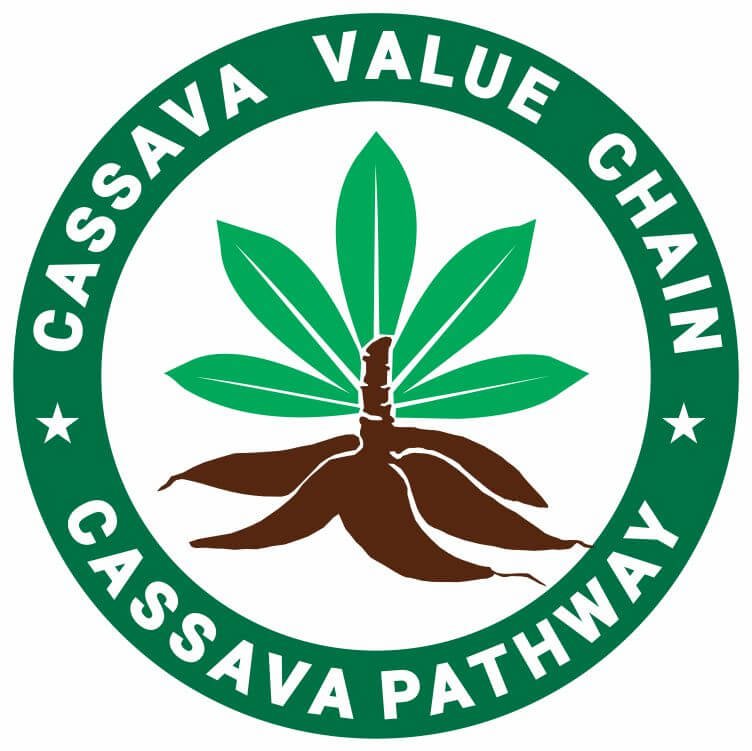Discover garri, the crunchy cassava flakes loved across West Africa! Learn how it’s made, from fermentation to roasting, and why it’s a staple in many diets.
Garri, also called cassava flakes have been a part of West African cuisine for centuries. Along with fufu, it is the most popular cassava by-product in the cassava value chain in Africa.
Cassava undergoes a fascinating transformation to become one of West Africa’s most essential food staples.
This crispy, fermented product starts with fresh tubers that are peeled, grated and left to ferment, enhancing its unique flavor.
After fermentation, excess moisture is removed through pressing, followed by drying and roasting to achieve the perfect texture.
A favorite across Nigeria, Ghana, and beyond, it serves as a quick, energy-rich meal, whether soaked with water and milk or molded into a smooth swallow dish.
Packed with carbohydrates and naturally gluten-free, it remains a reliable source of sustenance for millions.
From farm to table, its production showcases a blend of tradition, skill, and deep cultural heritage passed down through generations.
In this blog post, we will explore the history of cassava flakes, nutritional benefits, and its many uses in West African cuisine.
Recommended: The Many Cassava Recipes You Should Know
Key Takeaways
- Garri is a popular cassava by-product, which has been a staple in West African cuisine for centuries.
- Garri is a nutritious food high in nutrients, making it essential for maintaining a healthy diet and digestive system.
- The Nigerian cassava flakes come in different types such as yellow, white, and Ijebu, each with its unique characteristics and popularity among consumers.
- The process of producing garri involves harvesting, peeling, washing, grating, fermenting, draining, sieving, and frying to create this beloved West African food staple.
What is Garri also Called Cassava Flakes?
Garri is a well-known West African cassava food made from fermented and roasted into cassava granules or flakes. As we are going to see in this article, the process of making cassava flakes involves peeling and grating cassava roots, fermenting the pulp to reduce its natural cyanide content, pressing out excess moisture, and then frying the dried granules in a wide pan.
The result, which is garri, is a crispy, coarse, or fine-textured product that can be eaten dry as a snack, soaked in water with sugar and milk, or cooked into a dough-like consistency known as eba, which is typically served with soups and stews.
Garri is highly valued for its long shelf life, affordability, and versatility in African cuisine.
Brief History of Garri
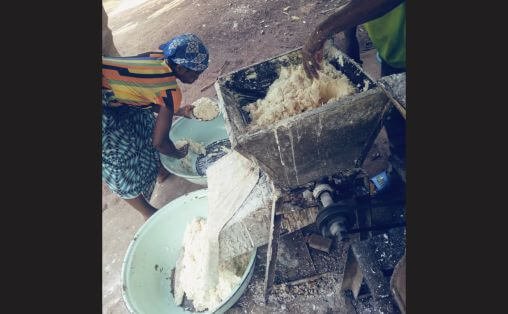
Garri has a long history in West Africa, dating back to the pre-colonial era.
The process of producing this popular cassava product involves peeling, washing, grating, fermenting, sieving, and then frying to get the flaky end product.
This process was developed by West African tribes as a way to preserve cassava root, which is highly perishable.
It quickly became a popular food staple in West Africa due to its long shelf life and its ability to be consumed in many ways.
Cassava flakes were often used as a substitute for grains like rice and corn, which were more expensive and harder to come by.
It became a symbol of resilience and survival in times of hardship, as it could be stored for long periods without spoiling.
Related Posts
- Tools and Equipment for Cassava Processing
- The Cassava Flour: Benefits and Uses
- What are Tapioca Flour and Starch?
- Cassava Foods Around the World
- Cassava Used in Livestock Feeds
- Easy Steps to Tapioca Balls
- The Many Cassava Products
- Traditional Cassava Processing Methods
The Nigerian Garri
The Nigerian garri is the most popular and cheapest food in the country. This owes to its cultivation by almost every family in the Southern part of the country.
In my hometown, hardly is there any family that doesn’t cultivate cassava, which will end up becoming cassava flakes through a process you will read the later part of this article.
The Nigerian garri is of many types, but the most popular are the yellow, the white, and the Ijebu garri.
The Yellow Garri
The Nigerian yellow cassava flakes are made by adding a few drops of red palm oil during frying to give it a yellow color.
While there is no difference between the yellow and the white Nigerian garri apart from the color, the yellow cassava flakes are well sought-after and more expensive.
The White Garri
As described above, the white version is made without adding the red palm oil during frying which leaves it plain and preferred by a lot of people for soaking.
The Ijebu Garri
Ijebu is a particular type of cassava flake from a place called Ijebu in South West Nigeria.
The people perfected the production of the cassava root into cassava flakes that became everybody’s favorite in the country.
Nutritional Benefits of Garri
Garri is not only popular, but it is also a nutritious by-product of cassava.
Cassava root, the main ingredient in its production, is high in carbohydrates, making it a good source of energy.
It also contains essential vitamins and minerals, including vitamin C, iron, and potassium.
One of the key nutritional benefits of cassava flakes is its high fiber content.
Fiber is important for maintaining a healthy digestive system and can help prevent conditions like constipation and colon cancer.
It is also gluten-free, making it a good option for people with gluten sensitivities or celiac disease.
Uses of Cassava Flakes in West African Cuisine
Cassava flakes can be used in a variety of ways in West African cuisine. It can be served in several ways:
Cold and sweet
Garri can be mixed with cold water, sweetened with sugar or honey, and served with peanuts, coconut, or dried fruits for a refreshing and nutritious snack or breakfast.
Hot and savory
Cassava flakes can be mixed with boiling water to form a dough-like paste, which is then served with various soups and stews, such as egusi, okra, or vegetable soup. This is a common way of eating cassava flakes in Nigeria.
As a pastry
It can be mixed with cold water, sugar, and butter to form a creamy, sweet paste that is then chilled and served as a dessert or snack. This is known as cassava flakes cake or pudding.
Cassava flakes can also be used to make a sweet pudding-like dessert, especially with the Ijebu garri, which is often served at special occasions and celebrations.
African Garri to the World
In recent years, cassava flakes have gained popularity beyond West Africa and can now be found in specialty food stores around the world.
This is more so because of the increased migration of West Africans around the world, where they yearn for home food items.
Cassava flakes are popular due to their simplicity, nutritional benefits, and unique flavor profile.
How to Locally Produce Garri from Cassava Roots
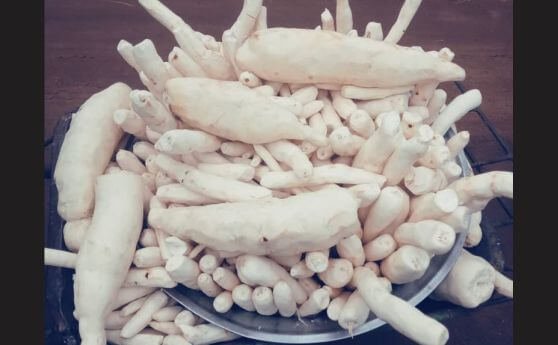
Garri is predominantly produced in the traditional way or locally in the West African region because it is cost-effective and a perfect way to reduce the toxicity of the cassava root.
Here is every step involved in processing the cassava root into the West African cassava flakes.
Growing up, we processed cassava flakes from cassava roots every other week as it is the most eaten food in Nigerian families.
We had a couple of mature cassava farms planted in the previous planting season.
While these mature farms serve, there are other fresh cassava farms cultivated in the most recent farming season.
This means while we harvest and use the mature farms, the freshly cultivated farms would replace them the next year, and the cycle continues.
Harvesting of Cassava for Cassava Flakes

The cassava processing into cassava flakes starts by harvesting the roots by pulling the stems just above the mound level to expose the roots so they can be cut with a knife or plucked with bare hands.
It usually requires a strong person to pull up the cassava roots because of the caked soil, more than 8 months after cultivation.
Peeling, Washing and Grating
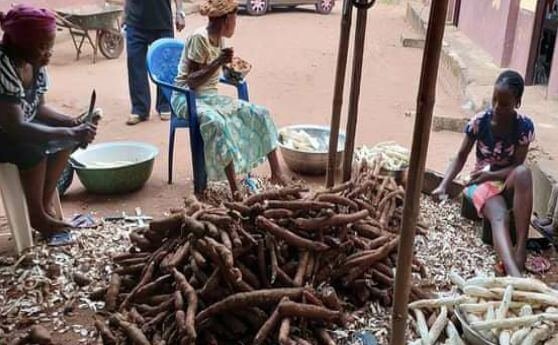
After harvesting, the roots are taken home and left for two days, after which they are peeled, washed, grated, and drained the same day.
Grating is the same as crushing and grinding the roots into a paste consistency, as you can see in the video and photo.
Of course, cassava root has excess water, and this must be reduced to the barest when used to produce cassava flakes.
The paste consistency is drained by using a bag with tiny holes to allow the excess cassava water to drain.
Draining is achieved with locally-made equipment that works by compressing the bagged cassava to press out the water.
See more on the processing of cassava.
Draining and Fermentation
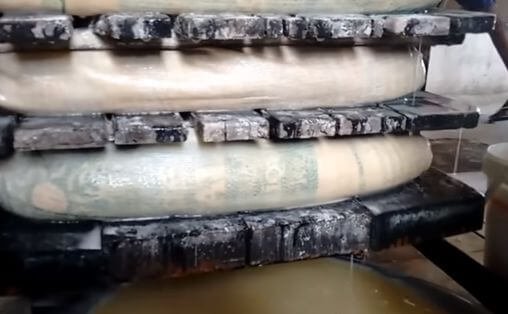
The draining of the cassava serves two purposes. While it drains, it ferments while sitting for two days.
The fermentation is necessary to neutralize the toxic compounds present in the cassava.
While draining helps to reduce the toxicity, fermentation doubles it up and makes it healthier to consume.
Sieving
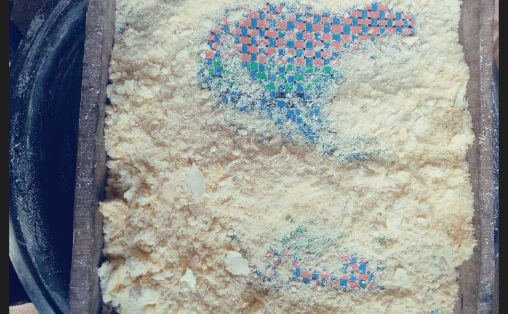
The cassava is retrieved after two days and sieved with a local sieve made of a basket.
Sieving the now-caked cassava is achieved by breaking the solid cassava chunks into manageable sizes that can pass through the sieving equipment.
Frying Cassava into Nigerian Garri
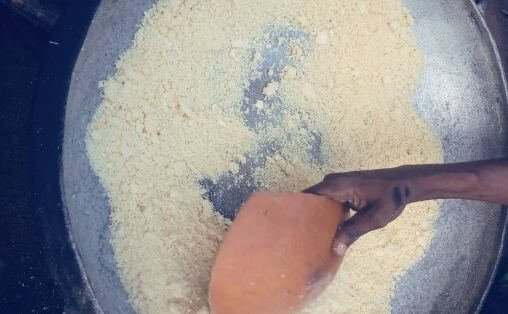
Frying is the last part before Nigerian garri is produced. The sieved cassava is scooped into a special pot, which is already set on the fire.
Depending on the size of the harvested cassava, there could be several frying sessions. The cassava is stirred until crispy and grainy, and it is ready to be used either for eba or for soakings.
It is important to note that during frying, the cassava can be turned yellow by adding drops of red palm oil as desired; if not, the end product is a white version.
The Modern Method for the Production of Garri from Cassava Roots
With the advancement of technology, a modern method for the production of cassava flakes has been developed to improve efficiency and quality.
This method involves the use of modern equipment and techniques to streamline the production process and ensure a high-quality end product.
The Washing Machine
The first step in the modern production of garri cassava flakes is washing. This is achieved by using an automated washing machine.
The washing machine removes sand and debris on the cassava tubers to avoid contamination during the rest of the processing.
After the washing and rinsing comes the peeling.
The Mechanical Cassava Peeling Machine
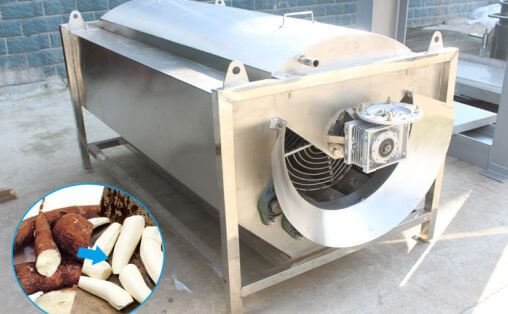
This is usually done using a mechanical peeler, which helps to remove the outer skin of the cassava roots efficiently.
The peeling is achieved by a sand roller, which is powered by a motor and makes use of friction between the cassava tubers and the sand roller.
The friction is such that the roots are peeled without damaging the inner part.
Also attached to the roller is a high-pressure spray nozzle that helps rinse the tubers while they are peeled.
Modern Grating Machine for Garri Production
The modern cassava grater or grinding machine is made up of the feed inlet or the bucket, the toothed roller, two-layer graters, the discharger, and the filter net. There is also the motor that powers the rollers.
The cassava roots are fed through the bucket inlet and received by the first layer, which chops the roots into sizeable chunks and sends them to the second layer for complete mashing of the roots.
Modern Dewatering Machine

The cassava dewatering or draining machine is powered by a hydraulic press to separate solids and liquids, removing excess water. It is also used for fruit juice extraction and vegetable dehydration.
The hydraulic press powers a stainless cylinder with a lead that holds the cassava to be drained.
It works by feeding the grated cassava paste into mesh bags and loading them into the cylinder and the lead is pressed to compress the loaded bags of cassava paste.
The pressure plate base is specially processed to ensure continuity, stability, and uniform dehydration.
Fermentation
It is worth noting that the cassava paste should be left for two days to ferment to completely remove toxicity. The cassava is left in the hydraulic press for these two days or removed and kept aside.
Milling
Once the cassava paste is fermented and dried, it is milled to produce a fine powder consistency, which is sieved to remove coarse or unwanted sizes of fibers and impurities before frying.
Modern Frying of Cassava into Garri
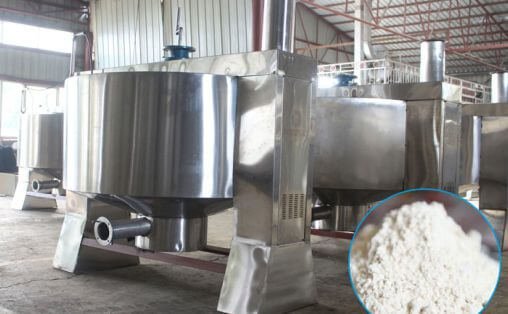
Frying is the second-to-last part of producing cassava flakes from cassava roots.
Frying equipment is a stainless-steel compartment with a heat source of either electric heating or diesel-burning heating.
The heat is transferred by conduction, which spreads the heat evenly on the stainless material.
Inside the compartment is a stirrer that continuously moves with a circular motion in the shape of the compartment.
The garri is ready when it becomes crispy and granulated. During the process, red palm oil could be added to get the yellow garri.
Final Sieving
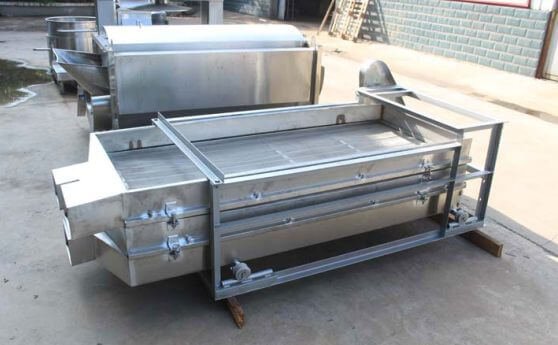
After frying, the cassava flakes are sieved to remove caked and uneven granules to make the final product even.
This is achieved by the sieving or sifting machine with a vibrating and moving mechanism that gyrates the particles through tiny holes big enough for the desired granular size.
After sifting, the product is conveyed to the bagging/packaging machine for weighing and sealing.
Garri Packaging Machine
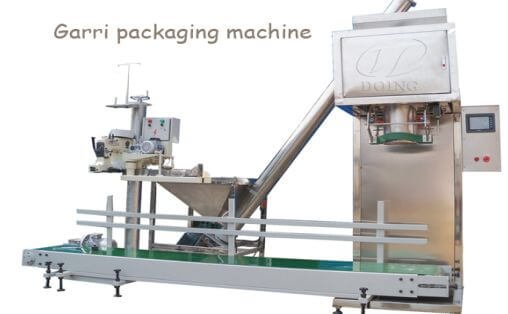
The garri packaging machine is the last part of the garri processing line. It is made of material import, feeder mechanism, weighing hooper, bagging, frame, sensor, conveyor belt, and pneumatic system.
The material is loaded into a buffer silo, then sent to a weighing hopper.
The screw conveyor speed controls the feed amount. When the set weight is reached, the weighing bucket gate opens, and the material enters the bag from the hopper.
The bagged product is conveyed away and sealed manually.
Frequently Asked Questions
What are the benefits of cassava flakes in the body?
It provides energy, aids digestion, promotes satiety, and contains essential nutrients like fiber, vitamins, and minerals, supporting overall health and well-being.
What is the nutritional value of cassava flakes?
Cassava flakes is rich in carbohydrates, fiber, vitamins (like vitamin C), and minerals (like calcium and iron), making it a nutritious food choice.
What is the English name of garri?
The English name is processed cassava flakes or granules, commonly consumed in Nigeria and other West African countries.
What is garri called in the USA?
In the USA, it is not commonly found or known by a specific name, but it can be referred to as cassava flakes or grits in some stores.
Final Word from Cassava Pathway
Garri is a popular cassava by-product that has been a part of West African cuisine for centuries.
Its long shelf life, nutritional benefits, and unique flavor profile make it a popular choice for meals, snacks, and desserts.
Whether enjoyed as a side dish or as a sweet treat, cassava flakes is a beloved food that reflects the rich culinary traditions of West Africa, especially Nigeria.
References
- https://www.bonappetit.com/story/what-is-garri
- What is Eba (Garri)
- The Garri – A Life Saver
- https://agricdemy.com/post/cassava-processing-nigeria
